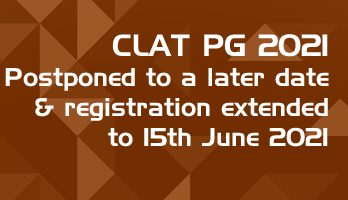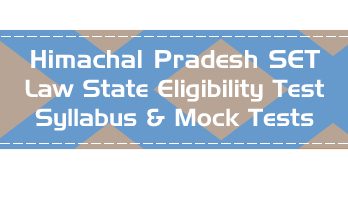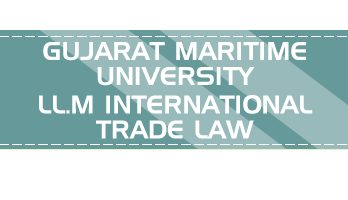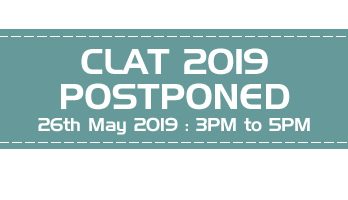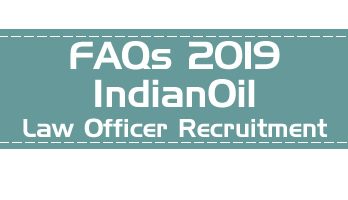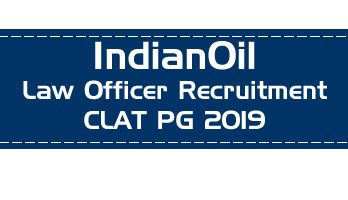Q : How do I crack the CBSE NET / JRF in law? What books should I study for all three papers? What method should be adopted – exhaustive or selective?
Ans :
Now it’s only two papers . . .
I answered a similar question yesterday. Copy-pasting the answer from the other question.
The UGC CBSE NET exam has been evolving over the past few years. Earlier, there were three papers; of which Paper III was an essay type paper.
In 2012, the Paper III was made into an objective type paper; so you can say that from 2012, UGC CBSE NET became a completely ‘objective’ type exam.
Now, having two law papers II & III as objective was somewhat redundant, since there was an overlap in what was covered in each paper.
From , there are only two papers; the general Paper I – common for all applicants; and the new Paper II – which is specific to the candidate’s chosen subject.
The length of new Paper II is now extended to 100 questions – up from the previous 50 Questions.
However, you can say that the overall length of the exam has gone down since now earlier Paper II had 50 Qs and Paper III had 75 Qs = Total 125 Qs.
The exam however still remains a tough-nut-to-crack; especially since the ‘pass %’ is now around 6% officially.
Syllabus :
Coming to the syllabus for the UGC NET Law exam, the overall syllabus has been published by the UGC. But there is no allocation of marks – like 20% from Constitutional law, 20% from … etc.
You can read about the complete UGC NET Law syllabus and analysis here.
Q : How do I crack the CBSE NET / JRF in law? What books and strategies are suggested? Which subjects are greater scoring? Is it necessary to have a deep study in it all?
Ans :
Old is Gold – I am referring to ‘Old question papers’ 🙂
The UGC CBSE NET exam has been evolving over the past few years. Earlier, there were three papers; of which Paper III was an essay type paper.
In 2012, the Paper III was made into an objective type paper; so you can say that from 2012, UGC CBSE NET became a completely ‘objective’ type exam.
Now, having two law papers II & III as objective was somewhat redundant, since there was an overlap in what was covered in each paper.
From , there are only two papers; the general Paper I – common for all applicants; and the new Paper II – which is specific to the candidate’s chosen subject.
The length of new Paper II is now extended to 100 questions – up from the previous 50 Questions.
However, you can say that the overall length of the exam has gone down since now earlier Paper II had 50 Qs and Paper III had 75 Qs = Total 125 Qs.
The exam however still remains a tough-nut-to-crack; especially since the ‘pass %’ is now around 6% officially.
Syllabus :
Coming to the syllabus for the UGC NET Law exam, the overall syllabus has been published by the UGC. But there is no allocation of marks – like 20% from Constitutional law, 20% from … etc.
You can read about the complete UGC NET Law syllabus and analysis here.
Q : How do I crack the CLAT (PG) in two months and join ONGC as a law officer?
Ans :
Next year !
I assume your question is pertinent to next year ? i.e. 2019, since your question is dated 8th May and the CLAT was scheduled for the 13th of May.
If the target is 2019, there is plenty of time to prepare; and I would suggest a gradual ‘ramp-up’ preparation of around 6 months.
While achieving a good rank in the CLAT PG is certainly possible with a 2 month focused prep; it will require a higher degree of concentration and effort.
Coming to the PSU roles via CLAT. The numbers are fluctuating every year; last year there were around 50 roles (in total) on offer across multiple PSUs, in , the number has gone down to 33 across three PSUs (ONGC, BHEL, PGCIL-POSOCO)
Though the younger generation may not have so much of a preference for ‘Government jobs’ as compared to the previous generations, PSU roles are still extremely popular – thanks to the relative job security, generous perks & benefits, good pay and work-life balance.
The part below is from my answer to a similar question . . . and the year I am referring to is 2017. But the picture has not changed much .
The question was about what should be the rank in CLAT PG to have a shot at the PSU roles on offer (including ONGC).
You cannot exactly predict a rank; You just need to prepare well, give it your best shot and hope for a high AIR.
Let’s do some quick analysis . . .
Looking at last year’s (2017) results 5475 candidates appeared for the exam and the AIR 1 was at 125 marks and the AIR 5475 was at minus 4.75 marks. (since CLAT has negative marking.)
Now, there are 632 PG seats through the CLAT PG and there will be around 50 PSU posts recruited through the CLAT PG.
So, a ranking of around 700 or higher should get you a PG seat somewhere or a PSU post.
However, PSU posts are quite attractive to a number of students; so the higher the rank the better. Though I don’t have any numbers / data – I would expect the PSU posts to get closed within AIR 250. (Apart from the CLAT ranking, there will also be GD, Interview etc. for PSU posts)
Last year’s ONGC cut-offs were :
Category Cut-off Score
UR 109.25
OBC 98.75
SC 90.25
ST 91.50
PWD (VH) 81.25
Bottom-line : Aim at scoring an AIR of within 250* or higher for a best shot at a PSU job.
Q : What is the steps to enroll as an advocate with Bar Council of India?
Ans :
The BCI is a ‘Umbrella Authority’, which sets the standards, makes the rules and governs the legal profession in India.
Whereas the actual registration of Advocates practicing in India is done by the State Bar Councils. The SBCs maintain the rolls of the practicing advocates.
When you pay the registration fees / annual fees etc. to the State Bar Council, part of it is the BCI fees.
You don’t need to register in the Bar Council of every state where you are practicing, just in the Bar Council of the state of your residence.
This link has the list of State Bar Councils in India :
Q : I have done LLB and my parents wish that I do LLM but I wish to prepare for UPSC and not waste more time as I am already 24. Is LLM advisable?
Ans :
Why not both ?
An LLM is a one year commitment and is almost a sure-shot thing; as long as you put in the minimum required effort, you will get your degree.
On the other hand, UPSC is a highly competitive exam; I found these numbers somewhere, which shows the funnel & filtration of candidates through the various steps.
- Year – 2017
- Prelims Appeared – 5 lakhs (approx)
- Prelims Cleared – 13,366
- Mains Appeared – (I don’t have the numbers)
- Shortlisted for Interview – 2568
- Final Selects – 990
Not every candidate get through in the first attempt, many of them have multiple attempts (even if the previous attempts were trail-runs, without complete seriousness)
Can a LLM course be part of your UPSC preparation ?
Since Law will be your subject in the UPSC, your LLM course will not be a totally different direction.
You will be focusing on one or more of the Law subjects in your LLM course, which will only add to and help in your UPSC preparation.
How do I balance the time required for LLM and for UPSC prep ?
Personally, I have seen that we often are at the highest efficiency when our schedules are tightly packed.
If I were to sit at home and try to completely focus on preparing for a competitive exam, I would probably manage only around 3 to 4 hours of focused study during the entire day; the rest of it goes off in distractions and other non-value-adding-activities.
But if I were to be trying to balance office or a full-time college course with my prep; I find that I still end up with almost the same amount of actual focused study time; and I also tend to concentrate better – since I know that I don’t have the full day at my disposal.
Another analogy would be that we tend to get work done faster and more efficiently – if we are running against a deadline, with some pressure.
So, think about it and decide depending on what is your ability to focus.
Of course, if you are going to be taking up a full-day UPSC preparation classroom course, then your LLM may be difficult.
Carry-over in LLM ?
While this is not a recommended approach, this is also a practical possibility . . .
Wherever you are planning to take up your LLM, read the carry over rules. In most places, you can complete the LLM class attendance requirement in one year and carry over all the papers for at least two years post that. So you will have two more years to complete your LLM exams.
If you enroll into an LLM and later find that it is clashing too much with your UPSC prep; just attend the classes to meet the minimum attendance requirement, keep paying the exam fees and flunk the exams. You can continue to focus on the UPSC and take up LLM exams later.
Note: This approach is ok only if you look at an LLM only as an additional degree. If your intention is to actually concentrate on a specialized area of law and use the LLM as a learning opportunity; you are better off focusing on one thing at a time.
How to prioritize ?
Consider various factors, such as
- Where do you realistically see yourself in terms of your ability to crack the UPSC?
- What are the applicable age limits and how much of a leeway do you have if you have to take up UPSC after LLM?
- What are your options and career preferences if you do not clear the UPSC exams?
- What is your ability to focus -concentrate and prepare full-time?
What would I have done in a similar situation ? (Strictly personal preference)
I would enroll for the LLM course. Start with my UPSC preparation in earnest and try to balance the work-load. If the LLM is clashing with my prep too much; I would then take a call.
Thanks for the A2A.
Q : How much time is taken by the Bar Council of India to give approval to a university after its satisfactory inspection?
Ans :
You need to check with the Bar Council on this . . .
As such the Inspection Manual document does not seem to have any expected or standard TAT for the approval process for a College / University.
Q : Can an LLB of age 60 years get himself registered for legal practice?
Ans :
Simply, Yes.
As on 8th May , in India;
There is no age restriction on pursuing your LLB degree.
There is no age restriction on state Bar Council registration.
There is no age restriction on taking up the Bar Council Exam (AIBE)
There is no limit on the number of attempts for clearing the Bar exam.
Therefore, there is no reason why a person with a LLB degree at the age of 60 cannot become a full-time practicing advocate.
Moreover, if the LLB degree has been completed before the 2009–10 academic year, even the AIBE is not mandatory. You can register with your state Bar Council and start practice.
Q : Which writers and competitive books are best for the CLAT PG?
Ans :
Re-posting my answer from a similar previous question . . .
The CLAT PG LLM entrance exam is a multiple choice objective type exam based on the entire LLB syllabus. But the crucial topics are Jurisprudence & Constitutional law – which together account for 2/3rd of the exam (66%).
Extensive theory is not the best way to prepare for multiple choice based exams. The ideal approach would be to solve as many MCQs as possible, covering the entire syllabus, with focus on the critical areas and solve all the previous papers you can find.
Solve at least two mock tests every day and after you have finished, re-attempt the ones from the previous day till you can blindly click on the right answer without thinking too much.
After all, almost 85% of the questions are repeats / variants from previous years or derived from ‘important questions’ from other similar exams.
The question poster then asked . . . Would it be possible to crack clat PG by studying only for a month?
Yes. Absolutely possible. If the paper had ‘subjective’ part, I would have had my reservations. But the advantage the CLAT LLM paper is :
(1) It is completely an objective paper
(2) There are no ‘analytical’ / ‘quants’ / ‘reasoning’ based questions
(3) A bulk of the questions emphasize more on memory & recognition skills (e.g. Which article says this . . . Which case is for what . . . What Salmond / Austin / Hart or Holmes said etc.)
(4) A significant number of questions are repeated / variations / adapted from previous exams or from other similar exams.)
So, the answer to your question is ‘Yes’.
What’s the approach?
Complete 2 (or preferably 3 or more) mock tests every day. Review the results carefully and make a note of the questions you got wrong and memorize the correct answers.
Repeat the process every day till you circle back to the first set of mock tests and just keep repeating the cycle.
In around 10 – 15 days, you will have become familiar with a bulk of the ‘important’ questions; and you will know the answer by instinct and your scores will start going up.
Most of the LLM entrance questions don’t need any explanation or reasoning . For example, look at the first 6 questions from CLAT PG listed below.
Once you know & remember the correct answer, you can answer these questions & any variations thereof.
1. If any question arises whether a Bill is a Money Bill or not, the decision given by the shall be final:
(a) Finance Minister
(b) Speaker of the Lok Sabha
(c) Vice-President
(d) Prime Minister.
2. Part IX-B of the Constitution of India dealing with the ‘Co-operative Societies’ was inserted by:
(a) The Constitution (Ninety Fifth Amendment) Act, 2009
(b) The Constitution (Ninety Eighth Amendment) Act, 2012
(c) The Constitution (Ninety Third Amendment) Act, 2005
(d) The Constitution (Ninety Seventh Amendment) Act, 2011.
3. Article 280 of the Constitution of India deals with:
(a) Finance Commission
(b) Election Commission of India
(c) Union Public Service Commission
(d) Comptroller and Auditor-General.
4. Which provision of the Constitution of India deals with the representation of the Anglo-Indian Community in the House of the People?
(a) Article 331
(b) Article 332
(c) Article 333
(d) Article 330.
5. In State of Maharashtra v. Dr. Praful B. Desai, 2003 SC the Supreme Court of India held:
(a) Right to speedy trial is part and parcel of Right to life under Article 21 of the Constitution
(b) It is obligatory on the employer to compute the family pension and offer the same to the widow even without making a claim on her part
(c) Where lawyers boycott or are on strike it is the duty of the court to carry on with court proceedings
(d) Recording of evidence through Vedio- conferencing so long the accused and/or his pleader are present while recording is as per “procedure established by law” and hence valid.
So, if the objective is to score high marks in the CLAT PG LLM, yes, one month of dedicated practice is good enough.
If you are appearing in the CLAT PG , we have published the
Q : With 90 marks in the CLAT PG, which NLUs will I get?
Ans :
( Adapted from my answer to a very similar question )
This is just a generic analysis . . .
First of all, the scores in the mock tests may or may not be a good indicator of what your actual scores will be.
If the mock tests have been designed with a higher degree of difficulty, you may actually score more marks in the real test! or it could be the other way round.
But, assuming that the mocks are a usable indicator, let us look at the previous years’ rank list, 13 people scored 90 marks, leading to the following ranks.
AIR – 426 to 438
Unreserved – 351 to 358
ST – 7*
SC – 15 – 16
OBC – 56 to 58
NRI Sponsored – 1*
(* 90 would have lead to this ranking, the actual ST – 7 was at 81.25 marks and NRI 1 was at 69.26 marks)
(Yes, all these ranks are for 90 marks. If multiple candidates score same marks – legal aptitude scores, age and random draw by computer are used to allot final ranks. There is the AIR and then there are category-wise ranks)
Now, there are 632 PG seats through the CLAT PG and there will be around 50 PSU posts recruited through the CLAT PG.
So, assuming that this year’s CLAT performance will also be along the same lines, the chances of landing a seat of his/her choice with a score of 90 in the CLAT will depend on the category of the applicant.
If you are a NRI candidate, you should get a seat in the NLSIU, Bengaluru. Whereas if you are in the Unreserved category, you will land a seat in one of the newer NLUs.
That said, take this analysis with a pinch of salt since there are too many variables and unknowns in the equation.
For example, several candidates with a higher ranking may opt for a PSU role instead of pursuing LLM.
A candidate with a higher rank may choose a newer NLU for various personal reasons.
You still have time to practice. Just prepare well, keep calm and give it your best shot and let things work out.
If you are appearing in the CLAT PG , we have published the
Q : How many students approximately appear in CLAT PG examination?
Ans :
CLAT – One name, two exams . . . CLAT UG & CLAT PG…
CLAT PG is for admission to the LLM programs in various NLUs.
For , there are 632 PG (LLM) seats through the CLAT PG and there will be around 50 PSU posts recruited through the CLAT PG scores.
Looking at last year’s results 5475 candidates actually appeared for the exam and the AIR 1 was at 125 marks and the AIR 5475 was at minus 4.75 marks. (since CLAT has negative marking.)
The number for this year should be in the same range.
Q : Can I crack the CLAT if I am getting an 85 in a mock?
Ans :
This is just a generic analysis . . .
First of all, the scores in the mock tests may or may not be a good indicator of what your actual scores will be.
If the mock tests have been designed with a higher degree of difficulty, you may actually score more marks in the real test! or it could be the other way round.
But, assuming that the mocks are a usable indicator, let us look at the previous years’ rank list, 61 people scored 85 marks, leading to the following rankings.
AIR – 5979 to 6039
Unreserved – 5059 to 5101
ST – 25 to 26
SC – 103
OBC – 574 to 577
NRI Sponsored – 186
(Yes, all these ranks are for 85 marks. If multiple candidates score same marks – legal aptitude scores, age and random draw by computer are used to allot final ranks. There is the AIR and then there are category-wise ranks)
There are around 2300 NLU seats through CLAT . (Including all reservations).
So, assuming that this year’s CLAT performance will also be along the same lines, the chances of landing a seat with a score of 85 in the CLAT will depend on the category of the applicant.
That said, take this analysis with a pinch of salt since there are too many variables and unknowns in the equation.
You still have time to practice. Just prepare well, keep calm and give it your best shot and let things work out.
Thanks for the A2A.
Q : When do you enrol for CLAT exams?
Ans :
For CLAT (UG & PG) 2019 . . .
This year’s ( ) CLAT is scheduled for the 13th of May and the last date for enrollment is over.
The announcement for the CLAT 2019 will happen sometime in late December ; and the enrollment window is usually open for around 3 months – from 1st Jan till end of March.
Irrespective of which NLU conducts the exam, the updates should be available on the CLAT official website :
Q : What are some simple tips and tricks for the CLAT exam for the LLM?
Ans :
The problem with the answers below is . . .
They are talking about CLAT, AILET etc.
This question is about CLAT LLM. Not CLAT UG, but CLAT PG.
CLAT UG & CLAT PG are two different animals. They might be held together and might be collectively called CLAT – but they are two different exams.
CLAT (UG) is open to candidates from all streams; hence the paper is also generic in nature. It will have Quants, GK, reasoning , English etc.
But CLAT PG or CLAT LLM is open to only LLB graduates. So the exam is completely based on the LLB syllabus.
There are no quants, no problem solving type questions, no generic GK etc.
Even the books / material suggested by the answers below pertains to CLAT UG. These books do not cover CLAT PG. Check and reconfirm on what books you are actually buying.
The CLAT PG LLM entrance exam is a multiple choice objective type exam based on the entire LLB syllabus. But the crucial topics are Jurisprudence & Constitutional law – which together account for 2/3rd of the exam (66%).
Extensive theory is not the best way to prepare for multiple choice based exams. The ideal approach would be to solve as many MCQs as possible, covering the entire syllabus, with focus on the critical areas and solve all the previous papers you can find.
Solve at least two mock tests every day and after you have finished, re-attempt the ones from the previous day till you can blindly click on the right answer without thinking too much.
After all, almost 85% of the questions are repeats / variants from previous years or derived from ‘important questions’ from other similar exams.
The question poster then asked . . . Would it be possible to crack clat PG by studying only for a month?
Yes. Absolutely possible. If the paper had ‘subjective’ part, I would have had my reservations. But the advantage the CLAT LLM paper is :
(1) It is completely an objective paper
(2) There are no ‘analytical’ / ‘quants’ / ‘reasoning’ based questions
(3) A bulk of the questions emphasize more on memory & recognition skills (e.g. Which article says this . . . Which case is for what . . . What Salmond / Austin / Hart or Holmes said etc.)
(4) A significant number of questions are repeated / variations / adapted from previous exams or from other similar exams.)
So, the answer to your question is ‘Yes’.
What’s the approach?
Complete 2 (or preferably 3 or more) mock tests every day. Review the results carefully and make a note of the questions you got wrong and memorize the correct answers.
Repeat the process every day till you circle back to the first set of mock tests and just keep repeating the cycle.
In around 10 – 15 days, you will have become familiar with a bulk of the ‘important’ questions; and you will know the answer by instinct and your scores will start going up.
Most of the LLM entrance questions don’t need any explanation or reasoning . For example, look at the first 6 questions from CLAT PG listed below.
Once you know & remember the correct answer, you can answer these questions & any variations thereof.
1. If any question arises whether a Bill is a Money Bill or not, the decision given by the shall be final:
(a) Finance Minister
(b) Speaker of the Lok Sabha
(c) Vice-President
(d) Prime Minister.
2. Part IX-B of the Constitution of India dealing with the ‘Co-operative Societies’ was inserted by:
(a) The Constitution (Ninety Fifth Amendment) Act, 2009
(b) The Constitution (Ninety Eighth Amendment) Act, 2012
(c) The Constitution (Ninety Third Amendment) Act, 2005
(d) The Constitution (Ninety Seventh Amendment) Act, 2011.
3. Article 280 of the Constitution of India deals with:
(a) Finance Commission
(b) Election Commission of India
(c) Union Public Service Commission
(d) Comptroller and Auditor-General.
4. Which provision of the Constitution of India deals with the representation of the Anglo-Indian Community in the House of the People?
(a) Article 331
(b) Article 332
(c) Article 333
(d) Article 330.
5. In State of Maharashtra v. Dr. Praful B. Desai, 2003 SC the Supreme Court of India held:
(a) Right to speedy trial is part and parcel of Right to life under Article 21 of the Constitution
(b) It is obligatory on the employer to compute the family pension and offer the same to the widow even without making a claim on her part
(c) Where lawyers boycott or are on strike it is the duty of the court to carry on with court proceedings
(d) Recording of evidence through Vedio- conferencing so long the accused and/or his pleader are present while recording is as per “procedure established by law” and hence valid.
So, if the objective is to score high marks in the CLAT PG LLM, yes, one month of dedicated practice is good enough.
If you are appearing in the CLAT PG , we have published the
Q : Is an LLM degree required to be approved by the Bar Council of India?
Ans :
It doesn’t matter . . .
BCI recognition is absolutely essential when it comes to LLB degrees – since only BCI recognized LLB grads are allowed to practice as advocates in India; and this is also essential for various career options based on the LLB degree, such as Judicial Services.
However, UGC recognition is essential for LLM degrees since an LLM does not qualify a person to practice law in India. An LLM is more of a specialization / stepping stone for entering the academic field etc.
In any case, I believe that for all UGC recognized LLM courses, the Bar Council does provide inputs on the syllabus / structure etc.
Bottom line(s):
- For LLB – Look for BCI recognition
- For LLM – Look for UGC recognition
If you are preparing for LLM entrance exams, do check out
Q : Could you proceed without the CLAT exams for a one-year LLM course in India?
Ans :
There are three ways to taking up an LLM course . . .
[1] Without any entrance exam – There are many tier-3 and some tier-2 Law Colleges across India, where admission is done on a first-come-first-admitted basis.
No entrance exam. Just meet the minimum criteria in terms of your previous academics and pay the fees. The basic eligibility will be 50% in your LLB. (45% for reserved categories)
Some even have a Distance education LLM programs.
[2] With entrance exam – there are tier 2 & tier 1 colleges that have their own entrance exam and in some states there is a common entrance exam for Law Courses across many participating colleges – tier 2 & 3.
For example, the Andhra Pradesh – AP PGLCET, Telangana – TS PGLCET, Kerala CEE , DU LLM entrance exam etc.
Bulk of the seats are filled through the exams, but there will usually be a ‘Management quota’ of seats with higher fees in private colleges that participate in these common entrance process.
Basic eligibility here is usually LLB with at least 50% or 55% (depending on the institute rules), with some relaxation for reserved categories.
[3] Through CLAT – CLAT is the common entrance exam for the National Law Schools / National Law Universities across India.
Basic eligibility is 55% in LLB (50% for reserved categories.)
Note : NLU Delhi and HPNLU Shimla do not participate in the CLAT as they have their own separate exam, eligibility is similar to CLAT.
Q : If I get enough marks in CLAT to get admission in the NLSIU Bangalore, but my first preference is the RMNLU Lucknow, can I get admission in the NSLIU (second preference)?
Ans :
Hypothetically speaking . . .
The counselling a.k.a. seat allotment process is designed such that students get their first preference seat, else their second preference, third preference and so on.
NLSIU is a much sough after institute that will be on the top of the list for many students.
The number of students who prefer other NLUs as their first choice will be quite less; and will be mostly driven by reasons such as proximity to home town and other personal reasons.
Now, there are 75+5 seats in NLSIU (including reserved seats)
So, if your ranking is probably within AIR 80 ~ 85, the chances of getting a seat in the NLSIU will be quite high (you need to do the math looking at the reserved quota and if you are eligible etc.)
If you are in the General category, you will have to get an AIR of at least 65 & above to get into one of the 55 seats. (Assuming that 10 students from within AIR 65 will opt for other institutes, take up a PSU job or drop out for other reasons.)
So, if your ranking is within AIR 65 and you opt for RMNLU as 1st preference and NLSIU as 2nd preference; you will surely get a seat in RMNLU and you will be out of the race for NLSIU.
However, if you mark your first preference as NLSIU, you will get either your 1st pref, else your 2nd pref.
Thanks for the A2A.
Q : Does DU have a 5-year law programme of a BA LLB / BBA LLB for ?
Ans :
AFAIK, No.
From what I know and what is published on the official website, DU faculty of Law does not have a 5 year integrated program.
They have a 3 year – six semester LLB program.
Q : How are the placements for MPP in NLSIU?
Ans :
The MPP is a relatively new program . . .
AFAIK, two batches have passed out so far. Going by the ‘recruiters’ list published by the NLSUI, the roster looks impressive and the type of work that these organizations do also looks very interesting.
However, I would prefer to get some real-time info from the alumni or current students.
How many students from the previous batches got placed?
At what level and what roles?
What was the comp packages offered?
Any student from the current batch would be the best source of inputs.
MPP is somewhat of a niche program and there is not going to be ‘bulk’ recruitment by any one recruiter; so there will be a wider set of organizations & NGOs, which will offer packages based on their internal policies.
That said, since NLSIU has the excellent reputation, the most convenient location (Bengaluru) and the extensive industry connect, I would assume that they would tap into the best roles in the Industry.
Check out this placement brochure for the official data. :
Q : Next year, I will be 21. Will I be able to write the CLAT?
Ans :
Yes.
As of today . . . (25th April )
There is no age limit for the 3 year or 5 year LLB across India – Including through the CLAT.
Though an age limit was introduced by the BCI, it was struck down by the court and it is not expected to come back anytime soon.
If an upper age limit is introduced in the future, it would be prospective, i.e. affect new admissions and not retrospective, i.e. will not affect students already enrolled.
And there is no upper age limit for State Bar Council enrollment or the Bar Exam . . .
Considering that there is no age limit for LLB and no age limit for the Bar exam or Bar council enrollment, we can say that there is no age limit on becoming an Advocate in India.
Note: The official CLAT website clearly says “There will be no upper age limit for UG Programme in CLAT .” whereas the website & brochure of the NLSIU says “not completed 20 years of age as on 1st July of the year of admission. In the case of candidates belonging to SC/ST and persons with disability, the maximum age limit shall be 22 years” . – Looks like the NLSIU website & brochure are not updated.
Q : How much can I earn after doing an LLM from DU?
Ans :
There is no answer to this question . . .
As such, there are no standards for deciding salary packages for LLM / LLB graduates.
Any figures that are mentioned officially or unofficially are just based on previous recruitments and also considering the ‘average’ packages that are likely to be given to candidates from a particular institute.
Depending on the organization you join; the role, responsibilities, the posting location and other factors, it might be anything between 25k PM to 1.25L PM or even more.
Packages also depends on prior experience and any special skill-sets that the candidate has.
Bottom-line :
[1] If there is a standardized campus recruitment process – there will be benchmarks based on previous years packages, type of recruiter etc. This data should be available with the placements office / student driven placement committee.
[2] If the candidate is applying for roles directly outside campus, there are no standards.


